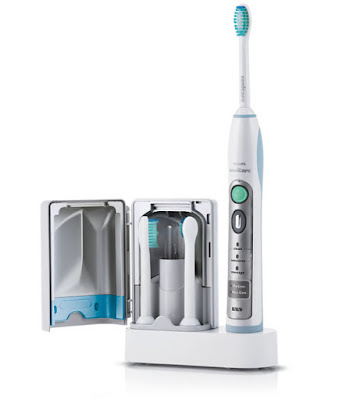Can an electric toothbrush brush your teeth faster than a manual toothbrush? Absolutely.
Is it worthwhile to spend $70 on an electric toothbrush? Yes. If you can afford to buy one, it will save you time and effort. You just need to hold the angle of the toothbrush correctly and it will do the job for you.
Comparing electric tooth brushing with manual brushing:
If the ultimate goal of brushing is to remove plaque and bacteria then either method can work as long as the end goal was accomplished – that is the removal of plaque. Research has found that electric toothbrushes are no more effective than manual toothbrushes, assuming that the people used a manual toothbrush effectively. [Source: Manual versus powered brushing]Research has concluded that the way brushing is done and the amount of time spent is more important than the choice of brushes. [Source: Meta Analysis]
Special features of an electric toothbrush:
Did you know the first electric toothbrush was invented in 1954 in Switzerland by Dr. Philippe-Guy Woog? It was created for patients with limited motor skills and for patients in braces. [Source: Wikipedia]Here are a few reasons why you should spend $70 on an electric toothbrush:
1. An electric toothbrush can have two types of action: vibration or rotation-oscillation. A vibrating toothbrush is similar to manual brushing, however, at a faster rate. A rotational oscillation toothbrush alternately rotates in one direction and then the opposite direction. They can both deliver around 20,000 to 50,000 strokes per minute compared to 100-300 strokes per minute with manual brushing.2. An electric toothbrush is classified based on speed, such as power brush, sonic brush or ultrasonic brush. If it is below 1000 oscillations per minute, it is a power brush. If it is below 20,000 oscillations per minute, it is a sonic brush. If it is above 20,000 oscillations per minute, it is classified as an ultrasonic brush. An ultrasonic toothbrush emits vibration in high frequency and low amplitude to break up plaque and bio film on teeth surfaces as well as up to 5mm below gum level.
3. An electric toothbrush comes with a small head to get to hard-to-reach surfaces, such as behind the last molars and around inside surfaces of the teeth.
4. An electric toothbrush can come with a bigger handle to make it easier for young children and adults with arthritis to operate.
5. An electric toothbrush is rechargeable so it can deliver the same force after it is fully charged.
6. An electric toothbrush has a 30-second beeping feature for each quadrant and a two-minute timer for entire mouth brushing.
Don't forget to change the brush head every 3-6 months or when the brush bristles are visibly worn out. If you decide to keep using a manual toothbrush, you can do so, just make sure you spend at least 2 to 3 minutes to brush, reach all surfaces including gum-line level to adequately remove plaque, and get in between the brackets. Brush and floss daily.
Dr. Nancy Phan and the team at Care Orthodontics in San Jose, CA love to see you with a beautiful and radiant smile. Please check out our website www.CareOrthodontics.com for more information about Invisalign or braces.
Resources:
1.http://en.wikipedia.org/wiki/Electric_toothbrush
2. Robinson PG, Deacon SA, Deery C, Heanue M, Walmsley AD, Worthington HV, Glenny AM, Shaw WC (2009). "Manual versus powered tooth brushing for oral health" Cochrane Database Syst Rev (1): CD002281. doi: 10.1002/14651858.CD002281.pub2. PMID 15846633 - Meta-analysis of studies of the effectiveness of electric toothbrushes.
3. Deery C, Heanue M, Deacon S, Robinson PG, Walmsley AD, Worthington H, Shaw W, Glenny AM (March 2004). "The effectiveness of manual versus powered toothbrushes for dental health: a systematic review". J Dent 32 (3): 197- 211. doi: 10.1016/j.jdent.2003.11.006. PMID 15001285

